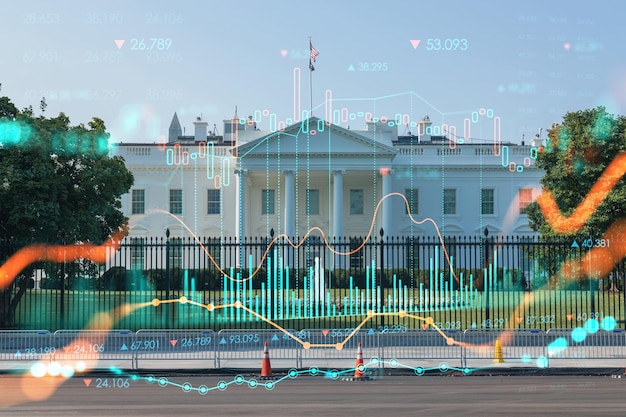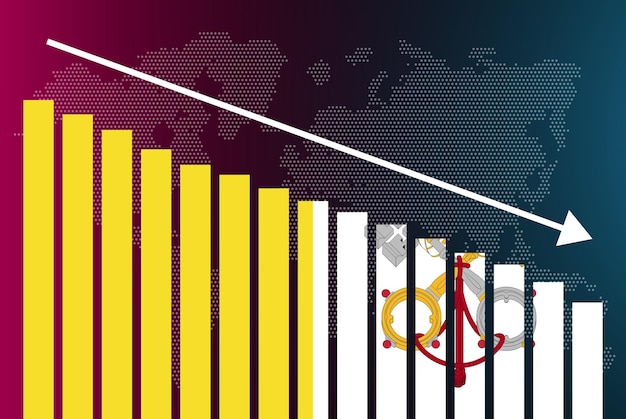Federal Government’s Response to Inflation and Economic Inequality

The federal government is addressing rising inflation and economic inequality through a combination of monetary policies by the Federal Reserve, fiscal measures including targeted tax credits and investments in social programs, and regulatory actions aimed at promoting fair competition and consumer protection.
The dual challenges of rising inflation and persistent economic inequality demand careful and multifaceted responses. This article explores how the federal government is responding to concerns about rising inflation and economic inequality, examining the approaches, policies, and potential impacts on American society.
Understanding the Economic Landscape: Inflation and Inequality
To fully grasp the federal government’s response, it’s crucial to understand the dynamics of both inflation and economic inequality. Inflation erodes purchasing power, disproportionately affecting low-income households, while economic inequality creates systemic disparities in access to opportunities and resources.
The Roots of Inflation
Inflation can arise from various factors, including demand-pull inflation (excess demand) and cost-push inflation (rising production costs). Supply chain disruptions, increased government spending, and expansionary monetary policies can also contribute to inflationary pressures.
Drivers of Economic Inequality
Economic inequality is influenced by factors such as income disparities, wealth concentration, unequal access to education and healthcare, and discriminatory practices. Technological advancements, globalization, and changes in labor market dynamics can also exacerbate inequality.
- Evaluate the impact of globalization on wage stagnation for low-skilled workers.
- Assess the role of tax policies in contributing to or mitigating income inequality.
- Analyze the effects of automation and artificial intelligence on job displacement and wage polarization.
- Examine the link between educational attainment and economic mobility.

Understanding these root causes is essential for designing effective governmental responses that address the underlying issues rather than just treating the symptoms. Both inflation and inequality have complex and interwoven causes that require holistic and targeted policy interventions.
Monetary Policy Levers: The Federal Reserve’s Role
The Federal Reserve (also known as The Fed) plays a critical role in managing inflation through monetary policy. By adjusting interest rates and influencing the money supply, the Fed aims to maintain price stability and promote full employment.
Interest Rate Adjustments
Raising interest rates can help curb inflation by reducing borrowing and spending. However, higher rates can also slow economic growth and potentially lead to job losses, presenting a delicate balancing act for the Fed.
Quantitative Tightening
Another tool in the Fed’s arsenal is quantitative tightening (QT). This involves reducing the Fed’s holdings of government bonds and other securities, which decreases the money supply and puts upward pressure on interest rates. It’s the opposite of Quantitative Easing (QE) that was frequently used to stimulate the economy during the pandemic.
- Analyze the historical effectiveness of interest rate hikes in controlling inflation.
- Assess the potential downside risks of quantitative tightening on financial markets.
- Consider alternative monetary policy tools the Fed could employ.
The effectiveness of monetary policy in addressing inflation often depends on the underlying causes of inflation and the overall economic conditions. For instance, monetary policy may be less effective in addressing supply-side induced inflation, which stems from shortages or disruptions in the supply chain.
Fiscal Policy Measures: Government Spending and Taxation
The federal government also utilizes fiscal policy to address both inflation and economic inequality. Fiscal policy involves government spending, taxation, and borrowing to influence the economy.

Targeted Tax Credits and Subsidies
The government can implement targeted tax credits and subsidies to provide financial relief to low- and middle-income families. These measures can help offset the impact of inflation and increase disposable income for vulnerable households.
Investments in Social Programs
Investing in social programs such as affordable housing, food assistance, and childcare can help reduce poverty and improve economic opportunities for marginalized communities.
These programs can provide a safety net for those struggling to make ends meet and help level the playing field. Direct payments and unemployment insurance can also address cyclical downturns to alleviate immediate financial pressures on households.
| Key Element | Brief Description |
|---|---|
| 🔥 Inflation Control | The Federal Reserve uses monetary policies like interest rate hikes to curb inflation. |
| 💰 Tax Credits | The government offers targeted tax credits to aid low- and middle-income families. |
| 📚 Social Investments | Funding social initiatives promotes economic equality and supports vulnerable populations. |
| ⚖️ Regulations | Regulatory measures ensure fair competition and protect consumers from unfair practices. |
FAQ
▼
The Federal Reserve primarily combats inflation by adjusting the federal funds rate, which influences interest rates throughout the economy. Higher interest rates can reduce borrowing and spending, thereby cooling down inflationary pressures.
▼
Fiscal policies aimed at reducing economic inequality include progressive taxation, which taxes higher incomes at a higher rate, and government spending on social programs like education, healthcare, and affordable housing.
▼
Government regulations can address economic inequality by ensuring fair labor practices, promoting equal access to opportunities, and preventing discriminatory practices in areas like hiring, lending, and housing.
▼
Raising interest rates can slow down economic growth, increase unemployment, and potentially trigger a recession. It can also negatively affect businesses by increasing their borrowing costs and reducing investment.
▼
Targeted tax credits can provide financial relief to low- and middle-income families, helping them cope with rising prices. However, their effectiveness depends on factors like the size of the credits and the number of people who receive them.
Conclusion
Addressing rising inflation and economic inequality requires a comprehensive and coordinated approach. While the federal government has various tools at its disposal, the effectiveness of these measures depends on careful implementation, ongoing monitoring, and adaptability to evolving economic conditions. The path forward demands a commitment to evidence-based policymaking and a focus on creating a more equitable and prosperous society for all Americans.
